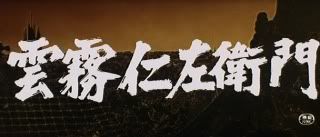
PLOT:
Wronged samurai turned crime boss Kumokiri Nizaemon (Tatsuya Nakadai) has assembled his rather large group of men for one final job, with which to cap off ten years of ruthless banditry: the hoodwinking and robbery of the district’s largest kimono wholesaler, Kichibei (Tetsuro Tamba). Unfortunately for Kumokiri and his band of thieves, they are being hotly hunted by an elite samurai squadron, led by Shikubu Abe (Shogoro Ichikawa), who are honour-bound to thwart them. Burglary, blood vendettas, and assassinations, all culminate in the sort of bloody showdown 70s samurai cinema is known for.
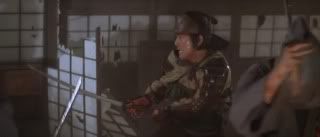
REVIEW:
Prepare to be confused for at least 50 minutes. Hideo Gosha’s nearly 3 hour chambara starts with a bloody nighttime raid, without bothering to introduce the situation first. Who’s being raided? Who’s doing the raiding? These are the sort of questions that don’t get answered until nearly an hour has passed, at which point Kumokiri addresses his assembled bandits and explains what their last mission is going to be. This is first time it’s actually clear who, out of the film's many characters, are “bandits”--and it’s most of them. Suddenly the actions of these characters are a little easier to suss out. This scene is followed by another expository scene, in which a blind masseur (Jo Shishido) explains Kumokiri’s identity to Abe, telling him (and us) what we probably suspect: that Kumokiri isn’t just some schmuck thief, but a disgraced samurai. After those scenes, everything else falls into place. However, they’re a long time coming, and I can see a few people giving up in frustration around the 30 or 40 minute mark, when important things are clearly happening, yet you still don’t have enough information to process them.
If you're a fan of Gosha, or the genre, though, I'd suggest you struggle through. It really isn't as bad as I may make it sound, and it's worth sitting through it to see Kumokiri's plan unfold.
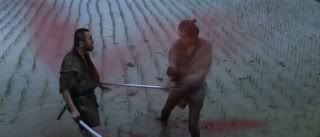
Anyway, anyone familiar with Gosha’s other movies should realize that, in a movie pitting bandit against samurai squadron, the director’s sympathies are going to be on the side of the bandits. Gosha doesn’t truck with samurai--at least, not the bushido-backing, honour-loving kind. Gosha’s (and the viewer’s) interest is clearly in Kumokiri and his band of merry men; however, the movie really fails to make a connection between the characters and the viewer. Part of it is because there are just so damn many characters; each one is only able to get a bit of screen time, making it difficult to develop a relationship with them. Even the character whom the movie is named after, Kumokiri, is fairly bland, but at least he’s played by Nakadai, so there’s something going on.
On top of all of that, the actual plot that Kumokiri and his men have hatched isn’t particularly interesting. Fans of heist films are going to be sorely disappointed that the big scheme merely involves one of the female bandits tricking Kichibei, the kimono merchant, into marrying her; once she’s done this, she need only locate his vaults and his keys, and the rest should be easy. Not exactly cloak and dagger stuff, but it is suitable enough to set up some late night raiding and some bloody sword fights, which is what you really want from the film in the first place.
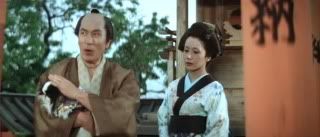
That said, I’d hate to sound like I was ragging on the film, which I thoroughly enjoyed, despite it’s obvious weaknesses. I’m a sucker for bloody samurai action, and Bandits vs Samurai Squadron delivers that in spades. In fact, I should be clear: if you want a bloody sword fight movie, this is probably one of the best. The violence starts with the opening raid, and then the film is punctuated by action throughout, easing the viewer through its lengthy duration. Gosha has always been a good action director, and here it really comes through. The fights are quite visceral, with lots of physical damage being done to the surrounding environment. Geysers of violent red blood erupt out of those unlucky warriors who find themselves on the business end of a katana.
I’d be lying if I said that the acting was also top notch, but you get good, genre-style stuff. Nakadai is a great as always, and while he’s not cinema’s strongest swordsmen he’s still a guy that knows how to make a fight look interesting. It’s a pleasure to see chubby-cheeked Jo Shishido as well, even if his part is underdeveloped and brief. The women of Bandits vs Samurai Squadron are largely there to be pretty, and often topless, though they do get a chance to show off their acting chops. 70s era Gosha is a lot closer to grindhouse cinema than his 60s incarnation.
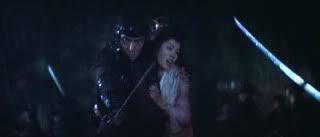
Bandits vs Samurai Squadron is a hell of a lot of fun, if you know what you’re getting yourself into. If you’re willing to sit back and wait for the film to start making sense, you’ll be treated to some great action scenes, my favourite being a rice-paddy duel between Kumokiri and the Samurai Squadron’s strongest swordsman. You’ll also be introduced (if you haven’t been already) to Gosha’s trademark pessimism--it isn’t much of a spoiler to say that no one is going to be riding happily off into the sunset in this one. Gosha would never allow it.










3 comments:
Nice review, Ash. I cover this film in my new book Warring Clans, Flashing Blades: A Samurai Film Companion (available from retail outlets in a few weeks). Would love to get your feedback.
Cheers,
PG
Thanks Patrick. I've noticed the listing for your book on Amazon, actually, and I was thinking about giving it a look.
Looking back at this review, I feel that I really didn't get across how much fun it is. There are a lot of negatives to focus on, but perhaps I spent too much time on them, considering how great the film actually is, for fans of the genre.
I really enjoyed this film. I actually quite liked that it's a long time until we have enough information to make sense of what's going on. It's a good hook; I wanted to know who everyone was, how they were connected, how this scene and that fit together. It also sets up a narrative approach that is carried on through the film: only at the very end is the final truth revealed.
For the most part I agree that we don't learn enough about the characters to care too much what happens to them, but I did find the relationship/backstory of Nakadai's character and his brother compelling. However, that may be due mostly to the innate drama of their situation and the typical intensity of Nakadai's performance.
Post a Comment